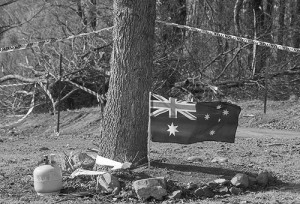
This photo was taken in an area of Australia that was devastated by bush fires a little over a year ago. The photographer’s comment on the photo is that it was a “reminder of the resilience and persistence of the bush and The Australian People.”
Further to my earlier post about ‘Resilience week’, today’s post on Agile BC related to the meaning of resilience and the concept of establishing a breaking point.
There is a research project at the University of Canterbury, in New Zealand, looking into Resilient Organisations. One of the principals of this project is Erica Seville.
They define Resilience as follows;
“Resilience is the function of an organisation’s
-
-
- situation awareness,
- management of keystone vulnerabilities and
- adaptive capacity
-
in a complex, dynamic and interconnected environment.”
Within each of the dot point heading above they identify 5 resilience indicators, if you want to explore all 15 indicators you should access the report here, but there are a couple of key attributes I would like to highlight.
Recovery Priorities & Connectedness
- Resilient organisations know what is truely improtant to them and how they connect into their environment
- Connectedness is not just about your supply chain
Participation in Exercises
- Robust exercises and crisis rehearsal enhance resilience
- Perfect practice makes perfect – poor practice re-enforces bad habits
Silo Mentality
- Silo mentality limits your ability to be resilient
- This also feeds into other attributes about communication, information sharing and decision making
Leadership
- How an organisation is led in both day-to-day and crisis mode is one of the most important features of the capacity to adapt and therefore overall resilience
- Emergency communications is part of this area
I am not sure that the Canterbury project has everything perfectly explained, however they have spent a great deal of time looking at the subject. Their approach to resilience seeks to effectively integrate the disciplines of Business Continuity, Risk Management and Emergency Management.
How do you define and measure resilience? Do you have a Crisis Management Team or a Crisis Leadership Team – they are not the same?
Ken, I have previously read the excellent work on resilience done by the Resilient Organisation team. As you can see from their benchmarking project, the measures of resilience are fundamentally behavioural. It is assumed that if the organisation has carried out this action or exhibits this behaviour then it will be more resilient. I don’t doubt this to be true but like yourself am interested in a measure(s) of the level of resilience delivered by these actions.
Ken, I have previously read the excellent work on resilience done by the Resilient Organisation team. As you can see from their benchmarking project, the measures of resilience are fundamentally behavioural. It is assumed that if the organisation has carried out this action or exhibits this behaviour then it will be more resilient. I don’t doubt this to be true but like yourself am interested in a measure(s) of the level of resilience delivered by these actions.
A very worthwhile research topic and one that needs lots of support.
Former senior public servant Paul Barratt AO has some specifics in mind in his 2009 paper entitled 'Organising for resilience' written for the not-for-profit organisation, Australia21.
for a free download, go to:
http://www.peoplefit.com.au
Best regards,
Barry Deane
Hello Barry, thanks for the comment and linking to the paper.